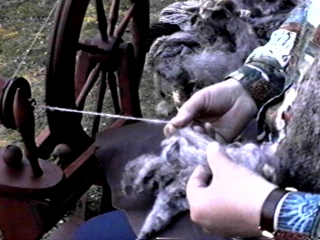Difference between revisions of "*History 8 The End of the Stone Age Video Notes"
(→13. How did spinning begin and what were the implications of the new clothing?) |
|||
| Line 55: | Line 55: | ||
http://www2.kenyon.edu/projects/farmschool/photos/spinbs.jpg | http://www2.kenyon.edu/projects/farmschool/photos/spinbs.jpg | ||
[http://www2.kenyon.edu/projects/farmschool/types/wool.htm] | [http://www2.kenyon.edu/projects/farmschool/types/wool.htm] | ||
| − | |||
-Irene Vazquez | -Irene Vazquez | ||
Revision as of 19:34, 24 October 2012
Return to Main Page History 8
Contents
- 1 1. Where did the Ghassoulians live? What did they produce and trade?
- 2 2. How did they overcome the lack of water in their area?
- 3 3. What rock was mined to produce copper?
- 4 4. Describe and give the effects of smelting. What effect did this have on trade?
- 5 5. What happened to the Ghassoulians? What was their legacy?
- 6 6. Who were the Beaker people? What was distinctive about their graves?
- 7 7.What were they creating that was different? What was the significance of this invention?
- 8 8. What was the impact of the Beaker People on Europe?
- 9 9. What two metals were combined to make bronze? What effect of bronze on armaments?
- 10 10. What were the effects of the introduction of the horse? On Social organization?
- 11 11. When was the wheel invented? What was its effect?
- 12 12. What item flowed from Europe back to the Middle East? What bound daily life?
- 13 13. How did spinning begin and what were the implications of the new clothing?
- 14 14. How are the contents of passage tombs different from the contents of the mound graves?
- 15 15. What was found in the pools? How does this show a development of religious thought?
1. Where did the Ghassoulians live? What did they produce and trade?
2. How did they overcome the lack of water in their area?
- Ghassoulians
3. What rock was mined to produce copper?
4. Describe and give the effects of smelting. What effect did this have on trade?
5. What happened to the Ghassoulians? What was their legacy?
6. Who were the Beaker people? What was distinctive about their graves?
The beaker people were a group of traders located in Europe. The beaker people had full sized coffins carved out of trees containing clothed bodies, bronze beakers and bronze weaponry. They are called the beaker people because of the beakers that they made, implying that they drank liquids other than water.
7.What were they creating that was different? What was the significance of this invention?
The Beaker people were the first to use fermentation to create alcoholic drinks. This was significant because it distinguished the rich from the poor. Only the rich people had the money for the sweeteners and were able to create these beverages. They quickly became used for religious ceremonies as well. They had one drinking cup that they would share and drink from it. They would hold it with two hands and pass it around from person to person. It became a large part of their lives. They were even buried with their drinking cups.

This is an image of a drinking cup that belonged to the Beaker People.
-Victoria Lima
Sources: “The End of the Stone Age” Video
Image: http://www.britannica.com/EBchecked/topic/57200/Beaker-folk
8. What was the impact of the Beaker People on Europe?
Named after their famous pottery drinking vessels, the Beaker people made a huge impact on the then Stone-age farmers in Europe. The Beaker people are widely accepted as the people who brought bronze to Europe. The Beaker People were known for their belief in individual worth, as exemplified by their individual burials instead of traditional mass, communal burials. The Beaker people brought a spirit of change to Europe, in addition to the art of smelting. The copper and eventually bronze tools developed by the Beaker people eventually gave rise to advanced warfare. Their namesake beakers were likely used in drinking rituals in which honey-based mead was consumed. The Beaker people, assimilated easily into the people previously residing in Europe, made a huge social impact by introducing copper, as the tools made from it were used in warfare in introduced classes. The ceremonies introduced to Europe made a big impact as well. Overall, the Beaker people brought about a great change in the technology, social structure, and culture of Europe.[1]
All information taken from class notes or from BBC website (see footnote 1).
-Christian Maines
9. What two metals were combined to make bronze? What effect of bronze on armaments?
10. What were the effects of the introduction of the horse? On Social organization?
11. When was the wheel invented? What was its effect?
12. What item flowed from Europe back to the Middle East? What bound daily life?
13. How did spinning begin and what were the implications of the new clothing?
The farmers in Europe were able to grow a new breed of sheep, specifically bred for its fleece. These new sheep had a fleece that was curly and dense. This was similar to today's wool. Because of this advance in breeding, they developed spinning to make use of it. As a result, clothing became warmer. Because the wool-making process was time consuming, it was only affordable for the wealthy; this led to wool clothing becoming a status symbol. After the wool was spun, it was dyed, which further made it a symbol of the elite.
-Irene Vazquez
14. How are the contents of passage tombs different from the contents of the mound graves?
15. What was found in the pools? How does this show a development of religious thought?
Cite error: <ref> tags exist, but no <references/> tag was found

